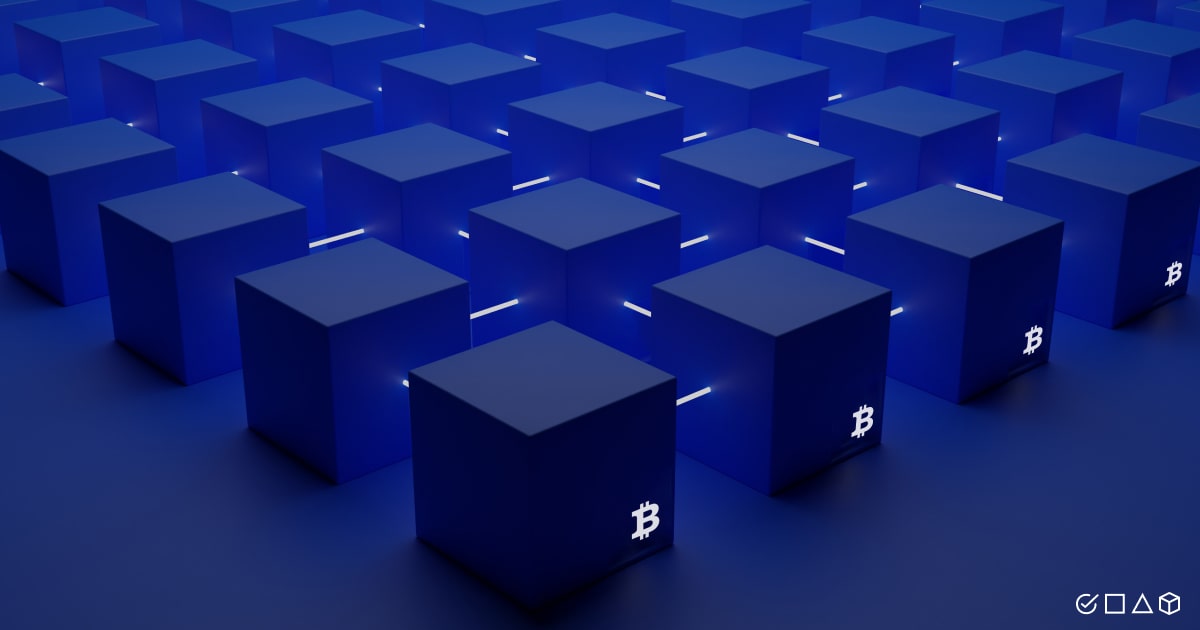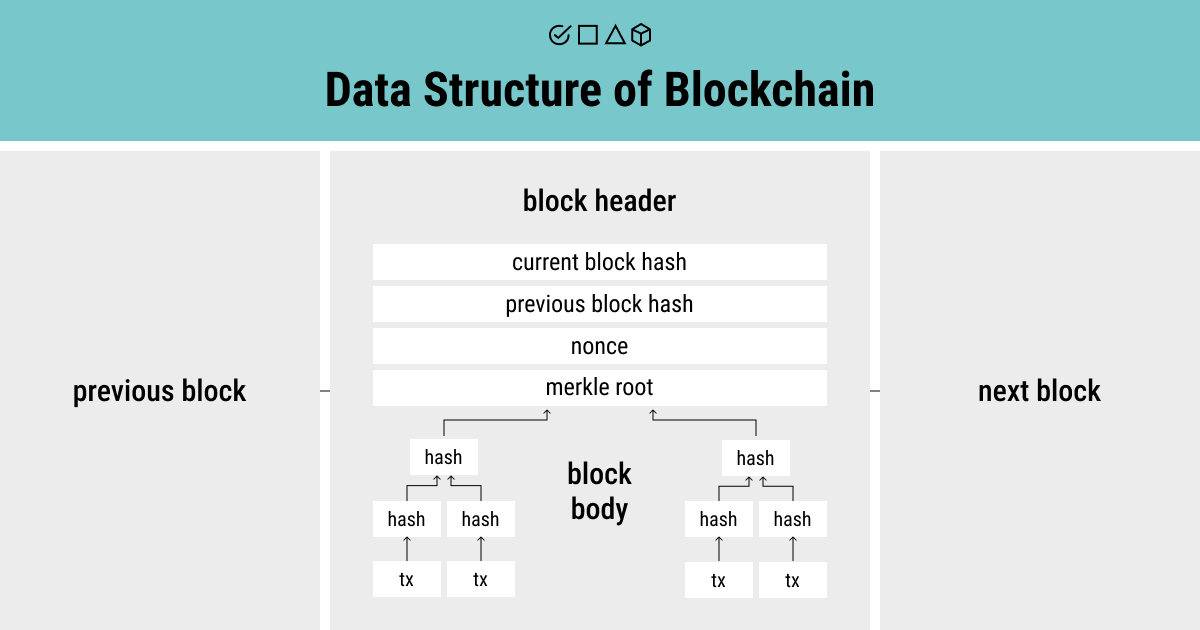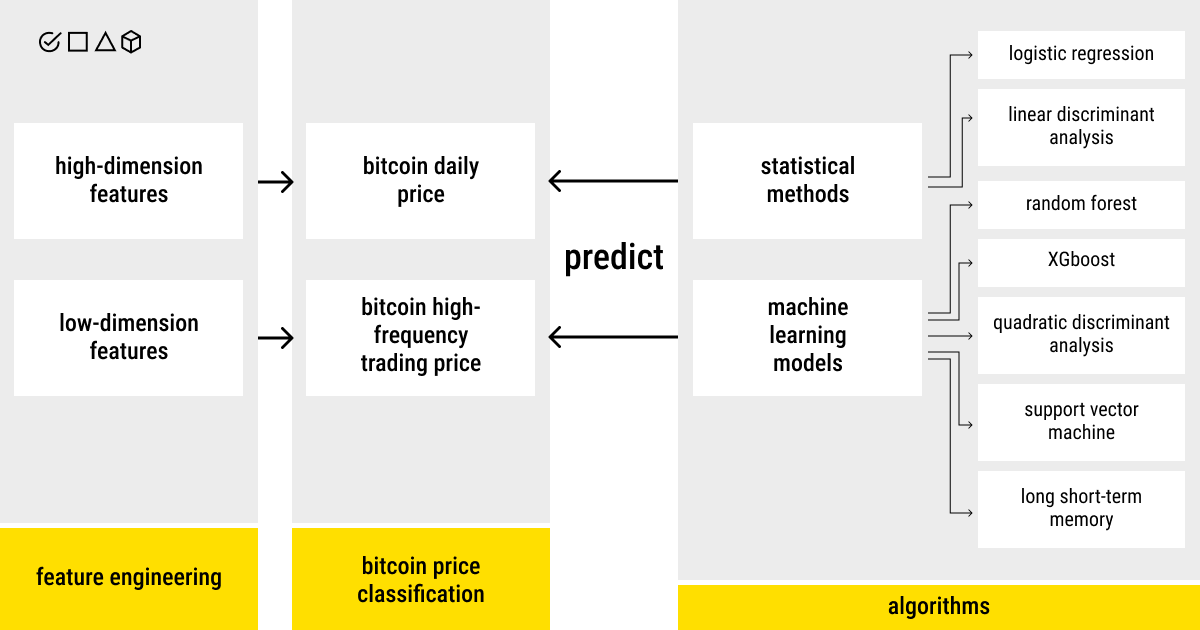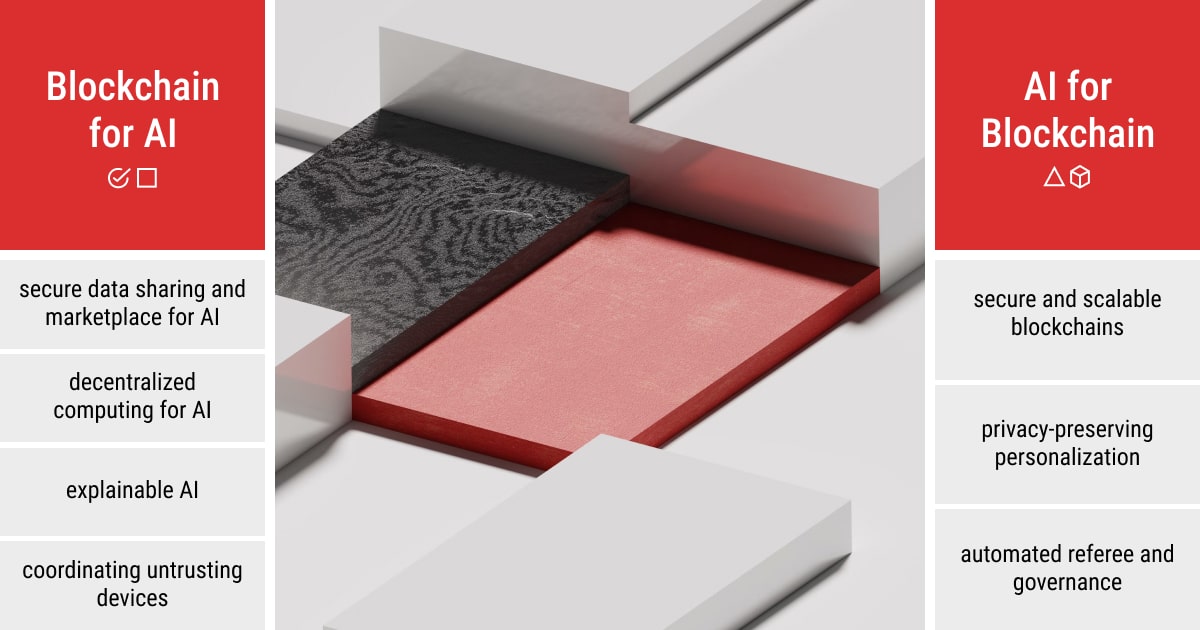Blockchain and AI: The Best of Both Worlds

There’s no such thing as perfect and flawless artificial intelligence, but one must admit that it’s by far the most advanced technology available today. But is there anything that can make AI even more powerful than it already is? Blockchain proves to be the solution.
Blockchain has been a trending topic for a while now, given the increased interest in cryptocurrency over the past few years. As of 2024, the blockchain market is estimated to reach $20 billion in revenue. Basically, blockchain is a technology that fuels modern cryptocurrencies, like Bitcoin or Ethereum. However, blockchain is more than just crypto. In fact, it has a tangible impact on many industries today, where it adds value to AI and significantly transforms almost every data-driven interaction, in which a modern human is involved. They include medical research or healthcare records, supply chains, etc.
Speaking technically, a blockchain is a digital, distributed ledger of transactions supported by a network of computers. A bit confusing, right? Let us explain in simple terms. A blockchain, as the name suggests, is a chain of digital blocks that stores a certain amount of data, and is difficult to hack or alter.
Blockchain is a distributed database, which can be shared across multiple users (aka nodes of computer networks). Doesn’t it remind you of something? Maybe cloud storage? These seem like similar concepts, but why is blockchain different? How did blockchain find common ground with machine learning in cryptocurrency and beyond? And why does blockchain hold such a leading role in the tech world?
In this article, we’ll try to answer these questions as accurately as possible and guide you through the world where data gains a whole new level of trust. Blockchain can be easy to grasp, and we’ll prove it to you. So let’s get started!
The Power of Machine Learning and Blockchain Technology

In essence, blockchain networks eliminate the need for an intermediary such as a bank, government, or credit card company to transfer value over the internet. It’s a secure, non-destructive way to maintain decentralized transactions in crypto and track data changes without a trusted third party. Blockchain stores data in blocks that are connected via cryptography. It can be either public, private, or consortium. How does this technology work in practice?
Let’s say you have the data that needs to be stored in the blockchain. This data enters a fresh new block of the digital ledger. And as this block gets filled with data, it binds to the previous one, which is how the data is chained together in chronological order. This data cannot be changed after it’s been recorded. Technically, it can, but this will result in the formation of a new block in the chain.
These transactions are also verified independently by peer-to-peer (P2P) computer networks, time-stamped, and only then can they be included in an expanding chain of verified data. You’re probably pondering now the question: how big are these blocks and how many of them can be in a single blockchain? Let’s have a look at the statistics!
The total number of bitcoins in circulation is 19,052,268.75. When fresh blocks are mined, this number updates every 10 minutes or so. The size of one block is limited to 1 MB, with about 4,000 transactions in each. So, why is the blockchain market growing so fast?
- It revolutionizes the way we can store and track valuable data;
- It builds trust in the data;
- It eliminates the need to engage a middleman.
That said, blockchain technology lays the groundwork for the modern and future interactions between each other. Or rather, data-driven interactions. How can the analytical power of machine learning come in handy here?
Blockchain for Machine Learning

Both machine learning and blockchain technology are a great match when it comes to efficient collaboration and automated decentralization. The combination of ML analytics and that level of trust in the data that blockchain provides is what enables smarter decisions, increased confidence, more automation, and decentralized intelligence. As a result, a machine learning and blockchain duo positively impacts business processes and improves financial performance.
We already know that machine learning can be different because it offers a variety of solutions to modern business problems. There’s also deep learning and reinforcement learning. All these methods are at the heart of big data analytics. Blockchain networks, in turn, form a system for storing and sharing big data with the help of smart contracts (the pieces of code).
This suggests that ML and blockchain can establish a robust partnership that revolves around data, its credibility, and all the data-driven decisions involved in the process. As such, blockchain ensures that data is secure and, thus, might stimulate data sharing during the ML model training and testing. Moreover, blockchain can be used for allocating computing powers, creating Internet of Things (IoT) networks, and building online predictive models with different data sources.
Are you into crypto? There are a variety of ML solutions for the cryptocurrency operations that we’ll discuss below. But meanwhile, you can send your data to us for annotation and get a free pilot if you are working on the crypto project in AI! Label Your Data knows the drill!
Machine Learning for Blockchain

A blockchain can affect and alter the traditional approach to machine learning and facilitate it. However, this collaboration works both ways. ML can also be useful for blockchain technology. Considering that blockchain systems produce large volumes of data from various sources, these distributed systems are harder to track and control than centralized ones.
How can ML help to deal with this issue? Machine learning is known for its great forecasting capabilities of system behaviors (e.g., trading forecasting) and efficient data analysis methods, which are essential for optimizing the blockchain mechanisms. Besides, ML models can be used to enhance data verification procedures, as well as to detect malicious attacks or fraudulent transactions in the blockchain.
So it’s important to examine how both technologies interconnect and can potentially transform the way we interact and rely on data. The analytical capacity of machine learning and the decentralized power of blockchain can be a real breakthrough in AI. That said, a distributed, decentralized, and unchangeable ledger that records data is combined with the decision-making process of the machine, a centralized process at its core. As a result, we have trustworthy data-driven decisions at our disposal and a more coherent, clear, and manageable process of handling data.
— Supervised & Unsupervised Machine Learning
Transaction Entity Classification
Recognizing entities behind potentially illicit nodes is fundamental in the Bitcoin network. One such process behind identifying entities behind addresses of nodes is known as address clustering. You are familiar with this term if you read our article about supervised and unsupervised learning. However, how does this work in blockchain?
Supervised learning algorithms are used to classify entities of transactions that might be related to cybercrime. The classification models, including random forests (77.38% of accuracy), extremely randomized forests (76.47% of accuracy), bagging (78.46% of accuracy), and gradient boosting (80.76% of accuracy), are trained using observations with categorical identifiers.
Bitcoin Price Prediction
Crypto is a volatile niche, so accurate price prediction is a burning need for making informed investment decisions. But how to predict cryptocurrency prices? Machine learning can be a viable strategy for bitcoin price prediction, yet the frequency and structure of the data must be considered when choosing the right ML algorithm for the most accurate bitcoin predictions. Otherwise, this might result in overfitting.
A discrete piece of bitcoin, UTXO (unspent transaction output), is used to keep track of how many bitcoins are involved in a transaction and of buying and selling information for the bitcoin price prediction. However, the topological features of other cryptocurrencies might also affect the bitcoin price.
ML models like the random forest, XGBoost, quadratic discriminant analysis, support vector machine, Bayesian regression, and long short-term memory are applied for bitcoin price prediction. They prove to be more efficient than the statistical methods (with a 67.2% accuracy rate). Other models include the block-transaction address model (BT-A) and a block-transaction entity-address model (BT-EA). Thus, automated bitcoin trading via machine learning algorithms seems a reality today.
— Deep Learning with Supervised Algorithms
Privacy and Security Preservation
Deep learning methods are at the forefront of dealing with real-world problems, like image classification or speech recognition. Blockchain, on the other hand, is a distributed, decentralized technology that can be accessed and controlled by all the system’s participants. Despite being a transparent and robust technology, blockchain might require additional privacy- and security-enhancing measures.
Privacy-preserving deep learning is a great fit for blockchain. DL regulates fairness, privacy, and accuracy, and helps detect and isolate low-contribution parties, thus fostering responsible participation. For instance, a blockchain-based privacy-preserving framework can be used to secure the process of sharing updates in federated learning. This ensures the security of data sharing and updating.
Computing Power Allocation
DL-based auction algorithm and blockchain form an efficient approach to optimizing edge computing resource allocation and supporting mobile mining activities. Mobile device miners can use the developed architecture to submit their bid valuation profiles to a single edge computing service provider in order to purchase more computing power. The deep learning-based auction mechanism generates more income and converges to an optimal value faster than traditional auction methods.
Cryptocurrency Power and Price Prediction
How to predict cryptocurrency with deep learning? Some DL-based cryptocurrency prediction algorithms that are most widely used include Recurrent Neural Networks (RNN) and Long Short-Term Memory (LSTM) networks. The LSTM model can recognize long-term dependencies, compared to the RNN model.
Obviously, you need to collect a cryptocurrency dataset, which usually consists of the following features, such as the opening price, daily high, daily low, closing price, hash rate, and mining difficulty. One can also build and train a bidirectional LSTM deep neural network for future crypto price prediction based on historical data using a DL framework, TensorFlow.
— Reinforcement Learning
IoT Networks
Let’s take a look at the example of the blockchain-based framework designed to secure data collection and sharing among mobile terminals (MTs) on an IoT network. This framework adopts multi-agent deep reinforcement learning to optimize data collection.
After the data is collected and verified by the certificate authority (CA), it receives a digital signature and is shared through a blockchain network, like for example Ethereum. Therefore, each mobile terminal can broadcast its transaction request, including the signature, the data, and the public key, to other nodes in the blockchain system for further validation procedure.
Through reinforcement learning, these MTs are able to collect much more data but also consume more energy. Even in the event of a denial-of-service attack, the blockchain-based data sharing architecture can keep all of the data transmitted by mobile terminals.
Bitcoin Mining
Cryptocurrency mining requires a considerable amount of computing power to solve a function on a blockchain by guessing a set of values. If the miner solves the function, they can add valid pending transactions on the blockchain. The goal of bitcoin mining is to update the blockchain network with pending transactions and receive rewards (i.e., bitcoins). However, it’s almost impossible to integrate blockchain into a mobile system because of the amount of computing resources.
Machine learning techniques can be applied to solve the issues regarding cryptocurrency mining, including its optimization and preventing the hijacking of mining resources. In particular, reinforcement learning is used to optimize the mining strategies of bitcoin and generate high profits.
Traditional RL algorithms offer strategies to maximize the number of rewards that agents can acquire in a given environment. However, because the blockchain network is a dynamic system, it’s difficult to develop a representative model. Some studies propose a multidimensional RL algorithm to optimize bitcoin mining using Q Learning (model-free method).
Trading
Machine learning algorithms are integrated into traditional trading bots that are used in the modern stock market. So, it’s no wonder that machine learning in crypto trading is a common approach to creating systems that trade the cryptocurrency markets.
With reinforcement learning, one can build a price forecasting model and a system that adjusts over a set period of time. It’s a workable strategy if you want to enhance the current cryptocurrency trading strategies to make them more profitable and adaptive.
How Does Crypto Synchronize with Artificial Intelligence?

AI-driven technology is a powerful tool to boost performance and yield fruitful results in the industry of interest. Artificial intelligence in crypto trading works the same way, or is rather transformed by the same token. The two robust technological ecosystems, such as blockchain and AI, can solve many shortcomings when combined.
AI and blockchain together can establish a secure, immutable, decentralized system for the highly sensitive data that AI-driven systems gather, store, and use. This consolidation leads to major data security advances using ML-based crypto models in a variety of industries, including medical, personal, banking and financial, trading, and legal data.
The following are some of the major benefits of integrating blockchain with AI:
- Decentralized intelligence;
- Improved data security and privacy;
- Enhanced trust in AI-driven decisions;
- Collective decision-making;
- Better efficiency.
Crypto is not a buzzword for the team of pros at Label Your Data! If you’re looking for a trusted data annotation partner for your AI project in crypto, send your quote request to us and enlist the support of true data experts!
Summary: How to Build Trust in Data by Mixing Automation and Decentralization

Even though blockchain technology is a hotly debated topic in the tech community, it still remains a complex concept to comprehend for many of us. In this article, we attempted to explain and analyze the ins and outs of blockchain networks and how they can work cohesively with machine learning techniques, and vice versa.
Without a doubt, machine learning solutions in crypto are by far the most popular and studied by AI researchers and crypto enthusiasts, which is why it was the main focus of learning about blockchain and ML. However, integrating traditional centralized ML and a fully decentralized blockchain system presents a wide scope of research and many promising solutions, awaiting us in the future.
Machine learning and blockchain establish a mutually beneficial relationship that is all about data. That said, if you use ML for blockchain management, you have a chance to achieve unprecedented data security. But at the same time, machine learning can reap the benefits of the decentralized nature of blockchain to build better models and tackle large volumes of data.
Written by
Karyna is the CEO of Label Your Data, a company specializing in data labeling solutions for machine learning projects. With a strong background in machine learning, she frequently collaborates with editors to share her expertise through articles, whitepapers, and presentations.

